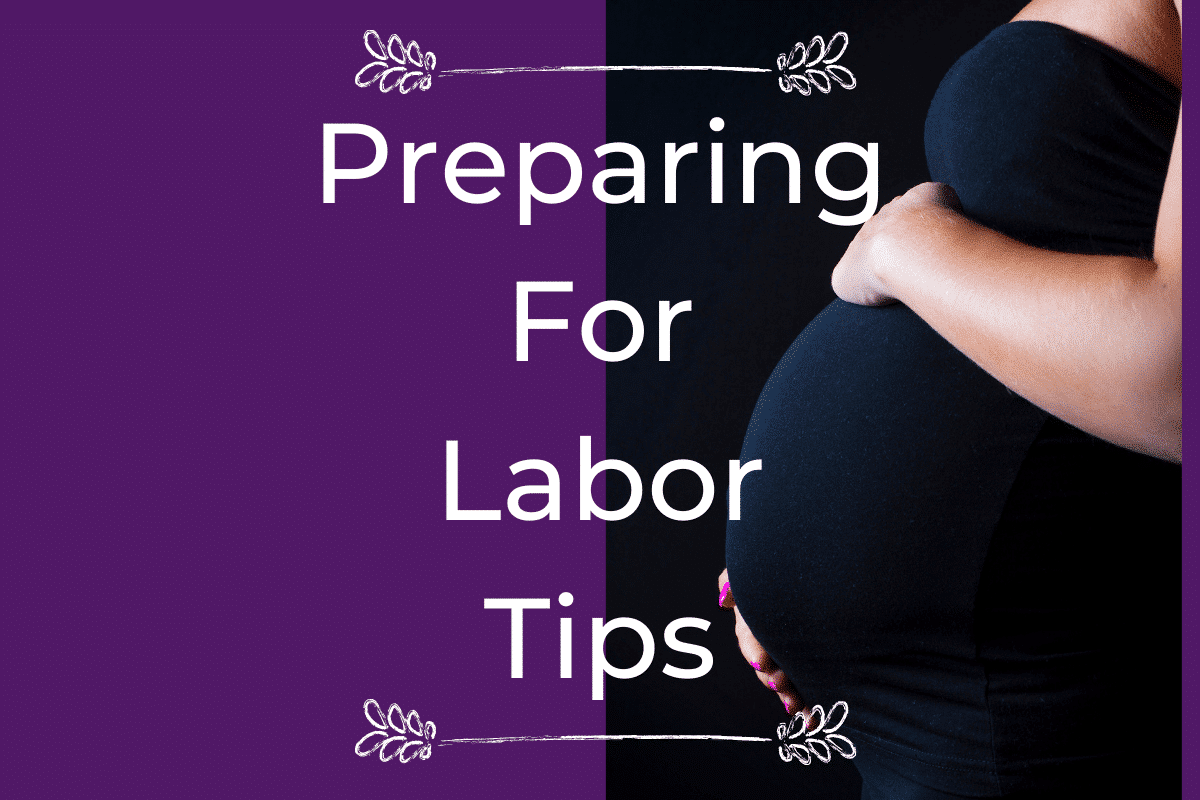Preparing for Labor: Helpful Tips and Hospital Checklist
Published on January 14, 2022 – Last Updated on May 9, 2022
Are you pregnant and preparing for labor? If so, you’re likely wondering what to do to prepare. Below, we’ve compiled a helpful list of tips and a valuable checklist to get you started. Remember, every pregnancy is different, so speak with your doctor about any specific concerns or preparations you should make. Good luck in the final weeks of your pregnancy – and congratulations!
What are the different ways you can have your baby?
- Vaginal birth is the most common way for babies to be born. During this process, your uterus contracts and helps push out the baby.
- Another common way for babies to be born is through cesarean section. This process involves an incision in your stomach and uterus and then removing the baby. A scheduled C-section (also known as elective or non-emergency cesarean birth) happens when the mom and doctor decide it’s best to deliver the baby via C-section rather than through vaginal birth.
- There are many reasons why you might want to have a vaginal birth after a cesarean (VBAC). If your doctor says that it’s safe for you, then go ahead and try!
How to prepare for labor?
The female body is a fascinating and fantastic machine designed to give birth. Your natural preparation for labor starts with the hormones released during pregnancy – but it doesn’t happen automatically! You can do things yourself (like take care of your health) to lower your stress when giving birth; otherwise, know what will happen without them.
A woman’s organs begin working together more closely than ever before, so she’ll be able to use all available strength during the delivery time- which means getting rid of lousy posture immediately because the strain on muscles causes tailbone pain/ discomfort.
Ensure the spine stays straight by keeping the head relaxed against the cushion behind the ears while sitting up tall — avoid placing anything under the knees, including a pillow. Instead, criss-cross one leg over another, gently pull back on your thighs to open hips, loop a belt around the scarf supporting your head, and loop it around your belly for gentle visuals of what happens in birth.
Have a birth plan prepared at all times. You can use our free printable birth plan template.

1. Childbirth Class at your hospital or birthing center
Birthing classes are an excellent way for pregnant moms to answer what will happen during labor and delivery. You can learn how to work through contractions or stay in control if medical complications arise, plus practice these strategies so that when it’s time for the actual birthday – you know exactly where everything is going on without an issue! Most women take their spouse/partner along as well, which helps them feel more confident because he knows just wanted she needs help or not.
2. Good Night Sleep Before Due Date
You are obtaining a good night’s sleep the last few weeks before labor is imperative to have energy for your body to do what it needs to do when going into labor. If possible, go on a short vacation and get some rest because going back home will be rough, too, because you’ll be having contractions while trying to get settled into a routine without a baby. You don’t want to have that on your mind any longer than it should be because you need to focus on the big day!
3. Focus and relaxation
While there are many methods to help you feel more prepared for labor and delivery, the proper techniques must be used and when. Contact a professional if your fear or anxiety gets too intense!
If all else fails-even, using visualization tools can help train our minds how we want them during this time so they don’t give us any trouble later on down low (pun intended).
4. Practice Hypnobirthing

Hypnobirthing combines a unique birthing method and emotional preparation that helps moms feel calm, confident, and prepared for their birth. In addition, hypnosis helps release endorphins-feel good hormones- plus it’s been shown in studies that those who practice this type of meditation have less medical intervention during delivery.
Since this technique has become popular, more hospitals are now offering classes to teach women who want to use this method- so ask the hospital staff if they do or contact your doctor for referrals.
Benefits of using Hypnobirthing:
- Have a positive birth experience.
- Useful for pain relief during pregnancy and birth.
- Reduce labor pain when the baby arrives.
- Learn more about Braxton Hicks Contractions.
- You can take the recordings into the delivery room.
- Bond with your new baby.
- Birth partner or family member support meditations.
We have compiled a list of the best hypnobirthing apps, and to keep it simple for you, you can download one of the best apps to prepare for your childbirth on the Birth App or Birth App iOS.
5. Create a Birth Plan
Planning ahead can make all the difference in how you feel during childbirth. Birth plans are a way for couples to clarify their expectations, and explore options that might be best suited based on personal preference or medical condition (like obesity)
It is also helpful to ensure staff is aware of anything special needed because of dietary restrictions like veganism/raw foods diets. So they don’t miss out due to confusion later on down the process!
It’s essential not just think about yourself – ask others what would work well too, such as companions who could stay overnight at home while mommy goes into hospital Week 1.
6. Take Breastfeeding Classes
Breastfeeding classes are an excellent opportunity for first-time moms and experienced breastfeeding couples. The education you receive will help ensure your baby is getting enough from both of us and teach proper latch techniques for bottle feeding later on down the road!
7. Take Parenting Classes
The key to being a good parent is knowing how and when you should be intervening with your child. They go through different stages where parents like us, the adults in their lives, who are responsible enough (or able), need to handle situations accordingly so that future problems don’t arise – but this can get overwhelming!
That’s why we recommend taking parenting classes: they’ll help explain what all these steps mean; teach valuable skills such as dressing appropriately or recognizing signs of illness before forwarding them onto doctor office visits without delay-and most importantly, give peace of mind knowing exactly where her wits at during each developmental stage!
8. Ask questions
Try to speak up when you have any questions about what will happen during labor and delivery. You can ask your doctor, who is more likely than not going to be present for most or all of the process; if he isn’t available, then reach out through other channels such as birthing class, where someone should know how things work anyway!
You can find a certified childbirth educator or midwife to assist you in the labor process or find a support person online to help you work through your pregnancy questions!

9. Preparing yourself for the hospital stay
Pack your hospital bag at least a week before going into labor, if not sooner, depending on how an early delivery may occur. For this bag to be packed, ensure it contains everything you need because labor and delivery time could be unpredictable. Also, try to pack a few extra things in case one of your visitors forgets something or two, like a toothbrush for mommy or daddy – especially if they didn’t brush their teeth before going into labor!
Here are some of the items you should bring with you to the hospital:
- Breast pads and nipple cream
- Your birth plan
- Toiletries and a hairbrush, hair ties, and headbands
- Body wash and shampoo
- Flip flops (because the hospital floors are not friendly to your feet)
- A little toy or stuffed animal for baby
- Pillow and blanket for dad or anyone else who will be sleeping on the couch (if you don’t plan on getting a private room)
- A list of your medications and allergies
- Camera with batteries and memory card
- Nursing bra & nursing pads
- Sleepwear
- A few day’s worths of comfortable clothing for mommy
- Going home outfit or clothes for baby
- Cell phone and charger
- Chargers for other electronics (like your iPad or Kindle)
- If you know that your hospital stay will require long hours, please make sure to pack comfortable clothes like yoga pants and a couple of t-shirts and comfortable shoes. You may also want to bring a sweater or two if the hospital air conditioning is too chilly.
- If you know that the hospital stay will be short, like for a scheduled c-section, you can pack a couple of dresses and a tank top, so mommy doesn’t have to worry about packing clothes.
- You may also bring a book or magazine to read while in labor.
Conclusion
If you’re pregnant and preparing for labor, we hope this article has been helpful. Remember to speak with your doctor about any specific concerns or preparations that may be necessary based on the individual pregnancy rather than generic information from a blog post. We wish you all the best in anticipation of welcoming your new baby!
Tags: childbirth classes, relaxation techniques, first baby, regular contractions







